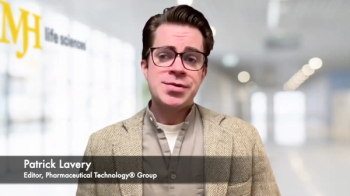Editor’s Note: This article was published in Pharmaceutical Technology Europe’s September 2022 print issue.
- Pharmaceutical Technology, September 2022
- Volume 46
- Issue 9
Delivering a Difference in Formulation
It is possible to overcome some of the limitations of traditional dosage forms by employing alternative drug delivery formulation strategies.
An increasingly ageing population, rise in chronic conditions, and intensified focus on paediatrics are trends perpetuating the need for the development of appropriate therapeutic regimens to which patients will comply correctly. To learn more about the role of alternative drug delivery formulation in expanding the potential indications of a drug product or improving compliance, Pharmaceutical Technology Europe spoke with Kimberly Shepard, associate director R&D, principal engineer, and Jonathan Cape, head of Multiparticulate Technology, both at Lonza Small Molecules; Brian Wilson, new business development, Celanese; and Wen Chin Foo, senior pharmaceutical scientist, Roquette Pharma Solutions.
Driving growth
PTE: What factors are currently driving growth in the alternative drug delivery formulation market? Are there any growth trends that will be important in the future?
Shepard (Lonza Small Molecules): For lung indications such as asthma and COPD [chronic obstructive pulmonary disease], local delivery by inhaler has been the standard of care for decades. Biotherapeutic treatments such as monoclonal antibodies (mAbs) have been approved more recently for lung indications, but via intravenous or subcutaneous administration. In cases where systemic administration is not needed for treatment, direct delivery to the lung would be hugely beneficial for the patients. There have been efforts in recent years to create dry powder inhaled formulation of these kinds of drugs, using spray drying as a single-step process to stabilize the fragile biomolecules, and engineer respirable particles for inhalation. The advantages for patients with lung conditions are, potentially, so significant that a continued focus on these formulations will be inevitable.
Cape (Lonza Small Molecules): There has been a real drive, over recent years, to develop dosage forms aimed at paediatric populations. These dosage forms are often distinct from adult products, with challenges ranging from taste masking, controlled release, and even bioavailability enhancement. CDMOs [contract development and manufacturing organizations] with the necessary experience and technologies have been taking a leading role in helping innovator companies develop commercializable products for the paediatric market. Both FDA’s [US Food and Drug Administration’s] Best Pharmaceuticals for Children Act (BPCA) and the European Medicines Agency’s (EMA’s) Paediatric Regulation incentivize companies to develop and commercialize products suitable for infants and children. The six months of market exclusivity they provide are a real incentive—two years in Europe for orphan indications—and it’s working, with maybe 15 paediatric approvals every year now in the United States. These incentives are proving a significant growth driver for paediatric products, including multiparticulate formulations, as they can be particularly useful when formulating medicines for these young patients.
Wilson (Celanese): Alternative drug delivery formulations can help overcome limitations of traditional dosage forms. These solutions are designed to provide improved bioavailability, reduced off-target effects, expanded compatibility across a variety of molecular classes, and lower treatment burden for patients. Market focus has been on identifying alternative dosage forms that offer sustained delivery of complex molecule types, with the goal to improve efficacy and provide better outcomes.
The industry is focused on innovating novel, sustained-release solutions to deliver biologics and RNA therapeutics. Sustained-release dosage forms allow precise delivery using improved targeting, localized delivery and solutions that help deliver drugs across physiological barriers, a recognized impediment to drug efficacy in the past. Success in sustained, controlled-release drug delivery represents an opportunity to reduce treatment burden and ensure patient adherence. Another interesting trend is the effort to improve patient outcomes through controlled release of multiple drugs concurrently. Fixed-dose combinations and multi-preventative technologies are potential applications of this approach.
Advancements to develop fixed-dose combinations and multi-preventative technologies for multiple pathways or multiple indications will continue. Oncology is an exciting therapeutic area where this trend has renewed focus and the concurrent delivery of multiple therapeutics may prove efficacious in treating heterogeneous tumours or the tumour microenvironment.
Foo (Roquette Pharma Solutions): The rising demand for innovative small-molecule drug delivery forms is being fuelled by the need to get more patients to adhere to their prescriptions. With the number of people aged over 60 years set to double by 2050 and global instances of chronic disease on the rise, the need for effective drug delivery formats has never been greater (1,2). Despite this, as many as 50% of patients do not take their medication as instructed (3). Pill fatigue, triggered by patients feeling overwhelmed by the amount of drugs they must take, is one of the many causes of medical noncompliance (4). Groups with specialized dosage requirements—like children, older adults, and people with disabilities—are especially susceptible to pill fatigue and other forms of nonadherence, because most conventional medications aren’t suited to their needs.
Alternative drug delivery forms such as orally disintegrating tablets (ODTs) and orally disintegrating films (ODFs) give pharmaceutical brands an invaluable opportunity to adapt. With a broader range of treatment options, drug makers can address a wider spectrum of clinical needs, improve bioavailability, reduce toxicity, and improve patient compliance.
In terms of large-molecule biologic drugs, there is a slow transition away from the traditional parenteral route (intravenous [IV], intramuscular, or subcutaneous injections) towards new and exciting delivery strategies. Intensive research is currently underway to overcome the unique challenges posed by biologic APIs and make them suitable for more patient-friendly delivery forms. Intranasal and pulmonary delivery strategies, for example, are actively being explored for protein and peptide therapeutics, in addition to buccal and transdermal administration for vaccines. Most of these alternative drug delivery formulations are still in the preclinical or clinical stages of development, but there have been a few examples of licensed products entering the market in recent years.
Avoiding attrition
PTE: How might alternative drug delivery formulation approaches help companies avoid potential attrition during development?
Foo (Roquette Pharma Solutions): While drug attrition has generally decreased over the past 10 years, the rate of failure still remains high—almost 90% by some estimates (5).Alternative small-molecule delivery routes offer manufacturers many advantages for increasing drug viability—from the potential to avoid first-pass metabolism to lower doses and fewer side effects—but they also present their own inherent formulation challenges. As with conventional drug formulations, these issues can be overcome through the judicious selection of functional excipients and a drug design tailored for commercial success. Cyclodextrins and their derivatives, for instance, are commonly used in nasal, ophthalmic, pulmonary, and transdermal delivery systems to improve drug solubility, permeation, and bioavailability, as well as the stability of pharmaceutical actives (6).
In biologic vaccine development, low toxicity and high immunogenicity are the key measures for success. Buccal administration of particulate vaccines using ODFs appears to be a promising strategy for eliciting an enhanced immune response, activating both mucosal and systemic immunity (7). In comparison to parenteral administration, this noninvasive vaccination route also delivers a higher rate of medical compliance and is better suited to the needs of vulnerable groups like paediatric patients.
Shepard (Lonza Small Molecules): For lung cancer in particular, dose-limiting toxicity has caused the failure in clinical trials of many promising candidates that are delivered systemically. To combat this, local treatment of lung cancer by the inhalation route is an area of great interest. Biotherapeutics delivered locally to the lung will have little to no systemic exposure, helping to reduce the risk of adverse effects in patients. It will also enable higher doses to be delivered directly to affected tissues. This same approach can also, of course, apply to lung indications outside cancer, from common diseases such as asthma to orphan conditions like idiopathic pulmonary fibrosis.
Cape (Lonza Small Molecules): Multiparticulate formulations consist of a large number of small particles, with each particle delivering the same unit dose. Typically, they will be 100–350 µm, might be CR/MR [controlled-release/modified-release] matrices or IR [immediate-release] matrices, and could also have CR/MR coatings. These particulates are then used to make the final dosage form: this could be an encapsulated product, a sachet, or a tablet. They can address numerous patient-centric and pharmacokinetic problems, and help de-risk clinical programmes, in addition to optimizing the product’s attributes.
For example, CR/MR multiparticulates, whether lipid-based or spray-layered cores, can address Cmax spikes during initial absorption that may lead to side-effects. Whichever way they are made, they can be coated to mask taste, or to give targeted release in the GI [gastrointestinal] tract. Furthermore, the multiparticulate intermediate flows through the GI tract with the fluid phase of GI compartments, reducing the propensity for gastro-retention that can occur with larger enteric coated tablets and capsules. All of these attributes can improve both performance and patient compliance and allow a more tailored approach to be taken for the medicine’s target product profile.
Wilson (Celanese): Therapeutics in development typically fail due to one or more of the following: formulation issues, poor ADME [absorption, distribution, metabolism, and excretion] properties, toxicity effects, or lack of efficacy. Alternative drug delivery dosage forms provide a path to overcome these common barriers associated with attrition in drug development.
Sustained-release implants and injectables are great examples of how ADME-related issues and toxicity effects can be overcome by a sustained, localized delivery approach. These sustained dosage forms are a unique way to mitigate problems associated with delivery across difficult physiological barriers. Localized delivery from an implant or injection can increase the therapeutic effect at the targeted compartment or tissue.
Oncology and CNS [central nervous system] are areas with high attrition rates that may benefit from the use of novel, sustained-release drug delivery formulations. These formulations can offer new routes for NCEs [new chemical entities] experiencing an impact from first pass metabolism, shorter plasma half-life, or toxicities at high concentrations.
Improving compliance
PTE: Can alternative drug delivery formulations aid with increasing patient compliance?
Wilson (Celanese): If we look at the ophthalmology market as a case study, low patient compliance can lead to vision loss or even blindness. The majority of the market is focused on developing approaches to reduce treatment burden and slow progression of diseases like glaucoma and age-related macular degeneration. Sustained-release dosage forms have found a home in this market where a six-month release implant can significantly improve patient compliance for a range of chronic eye diseases.
Foo (Roquette Pharma Solutions): Alternative drug formats give manufacturers greater scope to tailor medications to patient needs, and in turn, improve compliance. Take ODTs [orally disintegrating tablets], for example—these dosage forms disperse on contact with saliva in the mouth, rather than needing to be swallowed and dissolved in the stomach. This aspect not only makes them easier to take for people with low ability to swallow, but also means they deliver a faster onset of action—further contributing to better adherence. For patients with acute dysphagia, intranasal administration routes are ideal for delivering small doses with minimal discomfort.
Extended-release dosage forms are another great example of how brands can combat pill fatigue with alternative formulation approaches. With this type of delivery method, patients can take just one dose, which is slowly released throughout the day, rather than having to take multiple pills at set intervals. Streamlining the dosing experience like this can have a profound impact on patients’ ability and willingness to complete their full course of medications. The benefits of gradual release formats are not confined to oral dosage forms either. Multiple day transdermal and subcutaneous depot formulations are prime examples of extended-release delivery routes that offer an effective alternative to traditional multi‑dose oral regimens. Transdermal microneedle patches for instance, provide a painless way to overcome the skin barrier in the delivery of large molecule biologics, and are therefore gaining popularity as an alternative delivery route for vaccines.
Shepard (Lonza Small Molecules): In many cases, biotherapeutics for lung indications must be delivered invasively, whether by IV infusion or subcutaneous injection. In the case of IV infusions, multiple visits to a medical provider will also be required. Formulating a biotherapeutic in a dry powder inhaler eliminates these invasive injections and offers the potential for convenient at-home administration.
Cape (Lonza Small Molecules): Multiparticulate formulations can address two significant problems patients can face, whether as clinical trial participants or once a drug is commercialized: problems with swallowing tablets or capsules (dysphagia), and the taste-masking of granule suspensions. Dysphagia is particularly common in paediatric and geriatric patients, and all too often is overcome via crushing a tablet or emptying a capsule, and then mixing with a suitable vehicle. But either way, mouthfeel is often poor, with the rough surface feeling like sand in the mouth, and heterogeneous particle sizes leading to them getting caught in the teeth. Multiparticulates are much more uniform in particle size distribution and are more likely to be easy to swallow with a better mouthfeel. If there is an enteric coating, this will remain in place rather than being destroyed or removed. Improving taste is important for paediatric patients, particularly for those who are unable to swallow a standard tablet or capsule. Coated multiparticulates can hide the taste in a suspension formulation, making it far more palatable. They are similarly useful for sachet or reconstituted powder formulations for adult populations. Either way, patient compliance is likely to be better.
References
1. WHO, “Ageing and Health,” Fact Sheet, who.int, 4 Oct. 2021.
2. PricewaterhouseCoopers, “Chronic Diseases and Conditions Are on the Rise,” Healthcare Insights, 8 May 2015.
3. J. Kim, et al., US Pharm., 43 (1) 30–34 (2018).
4. E. Roy, “Pill Fatigue,” Keppel Health Review, 25 Feb. 2022.
5. F. Pammolli, et al., J. Transl. Med., 18, 162 (2020).
6. S. Jacob and A.B. Nair, Drug Dev. Res., 79 (5) 201–217 (2018).
7. R.P. Gala, et al., AAPS PharmSciTech, 18 (2) 283–292 (2017).
About the author
Felicity Thomas is the European/senior editor for Pharmaceutical Technology Group.
Article details
Pharmaceutical Technology Europe
Vol. 34, No. 9
September 2022
Pages: 13–15
Citation
When referring to this article, please cite it as F. Thomas, “Delivering a Difference in Formulation” Pharmaceutical Technology Europe 34 (9) 2022.
Articles in this issue
about 3 years ago
Pfizer’s Idea Orchardabout 3 years ago
Exploring Options for Optimizing Cell Line Developmentabout 3 years ago
Reducing Blind Spots in the Pharma Supply Chainabout 3 years ago
Delivery Kinetics for Topical Drugsabout 3 years ago
A Harmonized Approach to Performing a Risk-Based Audit Trail Reviewabout 3 years ago
Advances in Environmental Monitoringabout 3 years ago
Robust Bioanalytical Studies Can Aid in Regulatory SubmissionsNewsletter
Get the essential updates shaping the future of pharma manufacturing and compliance—subscribe today to Pharmaceutical Technology and never miss a breakthrough.






